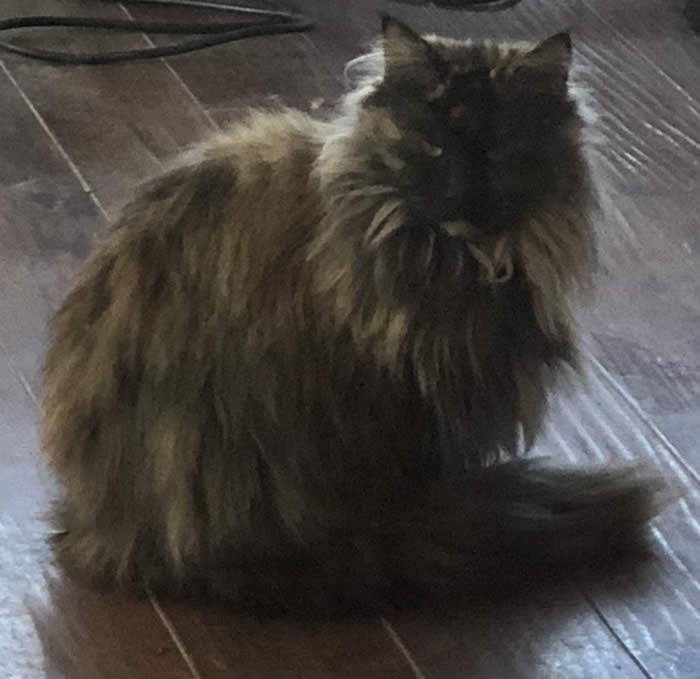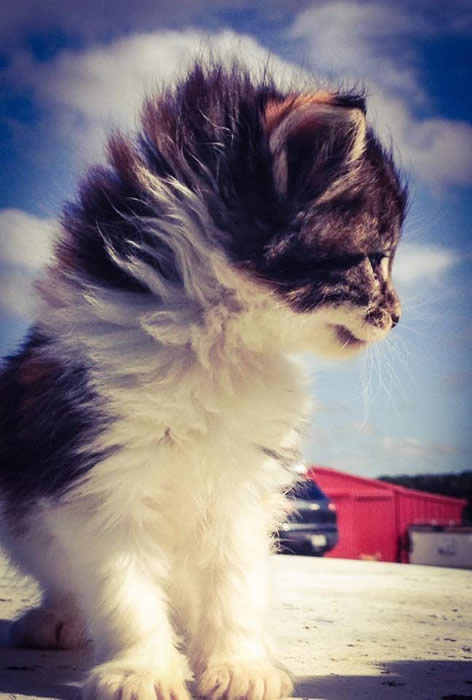Kittens available soon! Check back on our KITTENS page often or message reeceRFM@aol.com to be placed on our wait list.
(Courtesy of fanciers.com)
One of the oldest natural breeds in North America, the Maine Coon is
generally regarded as a native of the state of Maine (in fact, the Maine
Coon is the official Maine State Cat). A number of attractive legends
surround its origin. A wide-spread (though biologically impossible)
belief is that it originated from matings between semi-wild, domestic
cats and raccoons. This myth, bolstered by the bushy tail and the most
common coloring (a raccoon-like brown tabby) led to the adoption of the
name 'Maine Coon.' (Originally, only brown tabbies were called 'Maine
Coon Cats;' cats of other colors were referred to as 'Maine Shags.')
Another popular theory is that the Maine sprang from the six pet cats
which Marie Antoinette sent to Wiscasset, Maine when she was planning to
escape from France during the French Revolution. Most breeders today
believe that the breed originated in matings between pre-existing
shorthaired domestic cats and overseas longhairs (perhaps Angora types
introduced by New England seamen, or longhairs brought to America by the
Vikings).
First recorded in cat literature in 1861 with a mention of a black
and white cat named 'Captain Jenks of the Horse Marines,' Maine Coons
were popular competitors at early cat shows in Boston and New York. A
brown tabby female named 'Cosie' won Best Cat at the 1895 Madison Square
Garden Show.
Unfortunately, their popularity as show cats declined with the
arrival in 1900 of the more flamboyant Persians. Although the Maine
Coon remained a favorite cat in New England, the breed did not begin to
regain its former widespread popularity until the 1950's when more and
more cat fanciers began to take notice of them, show them, and record
their pedigrees. In 1968, six breeders formed the Maine Coon Breeders
and Fanciers Association (MCBFA) to preserve and
protect the breed. Today, MCBFA membership numbers over 1000 fanciers
and 200 breeders. By 1980, all registries had recognized the Maine
Coon, and it was well on its way to regaining its former glory.
Maine Coons were well established more than a century ago as a
hardy, handsome breed of domestic cat, well equipped to survive the
hostile New England winters. Nature is not soft-hearted. It selects
the biggest, the brightest, the best fighters, and the best hunters to
breed successive generations. Planned breedings of Maine Coons are
relatively recent. Since planned breeding began, Maine Coon breeders
have sought to preserve the Maine Coon's "natural," rugged qualities.
The ideal Maine Coon is a strong, healthy cat.
 Interestingly, the breed closest to the Maine Coon is the Norwegian
Forest Cat which, although geographically distant, evolved in much the
same climate, and lends credence to the theory that some of the cats
responsible for developing the Maine Coon were brought over by the
Vikings. Interestingly, the breed closest to the Maine Coon is the Norwegian
Forest Cat which, although geographically distant, evolved in much the
same climate, and lends credence to the theory that some of the cats
responsible for developing the Maine Coon were brought over by the
Vikings.
Everything about the Maine Coon points to its adaptation to a harsh
climate. Its glossy coat, heavy and water-resistant, is like that of no
other breed, and must be felt to be appreciated. It is longer on the
ruff, stomach and britches to protect against wet and snow, and shorter
on the back and neck to guard against tangling in the underbrush. The
coat falls smoothly, and is almost maintenance-free: a weekly combing is
all that is usually required to keep it in top condition.
The long,
bushy tail which the cat wraps around himself when he curls up to sleep
can protect him from cold winters. His ears are more heavily furred
(both inside and on the tips) than many breeds for protection from the
cold, and have a large range of movement. Big, round, tufted feet serve
as 'snow shoes.' Their large eyes and ears are also survival traits,
serving as they do increase sight and hearing. The relatively long,
square muzzle facilitates grasping prey and lapping water from streams
and puddles.
Although the Yankee myth of 30-pound cats is just that, a myth
(unless the cat is grossly overweight!), these are indeed tall,
muscular, big-boned cats; males commonly reach 13 to 18 pounds, with
females normally weighing about 9 to 12 pounds. Add to that two or three
inches of winter coat, and people will swear that they're looking at one
big cat.
Maine Coons develop slowly, and don't achieve their full size until
they are three to five years old. Their dispositions remain kittenish
throughout their lives; they are big, gentle, good-natured goofs. Even
their voices set them apart from other cats; they have a distinctive,
chirping trill which they use for everything from courting to cajoling
their people into playing with them. (Maine Coons love to play, and many
will joyfully retrieve small items.) They rarely meow, and when they do,
that soft, tiny voice doesn't fit their size!
While Maine Coons are highly people-oriented cats, they are not
overly-dependent. They do not constantly pester you for attention, but
prefer to "hang out" with their owners, investigating whatever activity
you're involved in and "helping" when they can. They are not, as a
general rule, known as "lap cats" but as with any personality trait
there are a few Maine Coons that prefer laps. Most Maine Coons will stay
close by, probably occupying the chair next to yours instead. Maines
will follow you from room to room and wait outside a closed door for you
to emerge. A Maine Coon will be your companion, your buddy, your pal,
but hardly ever your baby.
Maine Coons are relaxed and easy-going in just about everything they
do. The males tend to be the clowns while the females retain more
dignity, but both remain playful throughout their lives. They generally
get along well with kids and dogs, as well as other cats. They are not
as vertically-oriented as some other breeds, prefering to chase objects
on the ground and grasping them in their large paws -- no doubt
instincts developed as professional mousers. Many Maine Coons will play
"fetch" with their owners.
The important features of the Maine Coon are the head and body shape,
and the texture and 'shag' of the coat. The head is slightly longer
than it is wide, presenting a gently concave profile with high
cheekbones and ears that are large, wide at the base, moderately
pointed, and well tufted inside. They are set well up on the head,
approximately an ear's width apart. Lynx-like tufting on the top of the
ears is desirable. The neck should be medium-long, the torso long, and
the chest broad. The tail should be at least as long as the torso. One
of their most distinctive features is their eyes, which are large,
round, expressive, and set a a slightly oblique angle. Overall, the
Maine Coon should present the appearance of a well-balanced, rectangular
cat.
Throughout their history there has been no restriction on the
patterns and colors acceptable, with the exception of the pointed
Siamese pattern. As a result, a wide
range of colors and patterns are bred. Eye colors for all coat
colors range through green, gold, and green-gold. Blue eyes and odd
eyes, (one blue and one gold eye) are permissible in white cats. There
is no requirement in the Maine Coon Standard of Perfection for
particular combinations of coat color and eye color.
Maine Coon owners enjoy the breed's characteristic clown-like
personality, affectionate nature, amusing habits and tricks, willingness
to 'help' with any activity, and easily groomed coat. They make
excellent companions for large, active families that also enjoy having
dogs and other animals around. Their hardiness and ease of kittening
make them a satisfying first breed for the novice breeder. For owners
wishing to show, the Maine Coon has reclaimed its original glory in the
show ring.
|

![]()
